Leadership and Transformation Report: Analysis of Leadership Styles
VerifiedAdded on 2022/12/12
|29
|7629
|365
Report
AI Summary
This report delves into the multifaceted concept of leadership, examining its critical role in organizational performance, employee management, and overall sustainability. The paper dissects three key components: transformational leadership, change leadership, and organizational transformation, with a primary focus on understanding change within the context of organizational operations and strategic planning. It correlates transformational leadership skills with change leadership, analyzing their impact on employee commitment to change, referencing a notable article by Herold et al. Furthermore, the report incorporates a reflective analysis of the author's personal leadership skills, evaluating strengths and weaknesses. Finally, it explores organizational transformation and the role of leadership within this context, including a hypothetical scenario to illustrate personal leadership contributions. The report covers various aspects of organizational performance, providing a comprehensive account of leadership and change management.
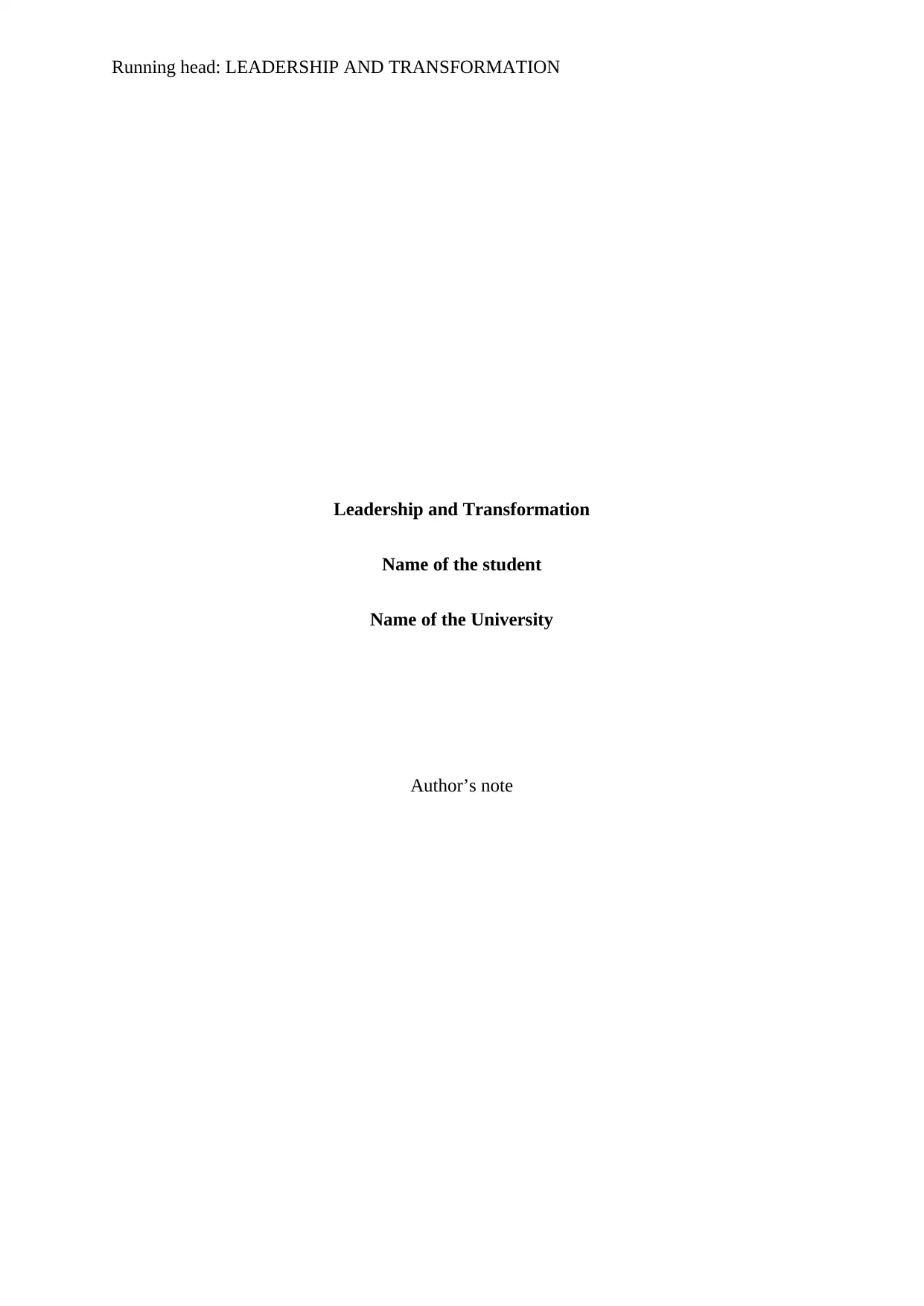
Running head: LEADERSHIP AND TRANSFORMATION
Leadership and Transformation
Name of the student
Name of the University
Author’s note
Leadership and Transformation
Name of the student
Name of the University
Author’s note
Paraphrase This Document
Need a fresh take? Get an instant paraphrase of this document with our AI Paraphraser
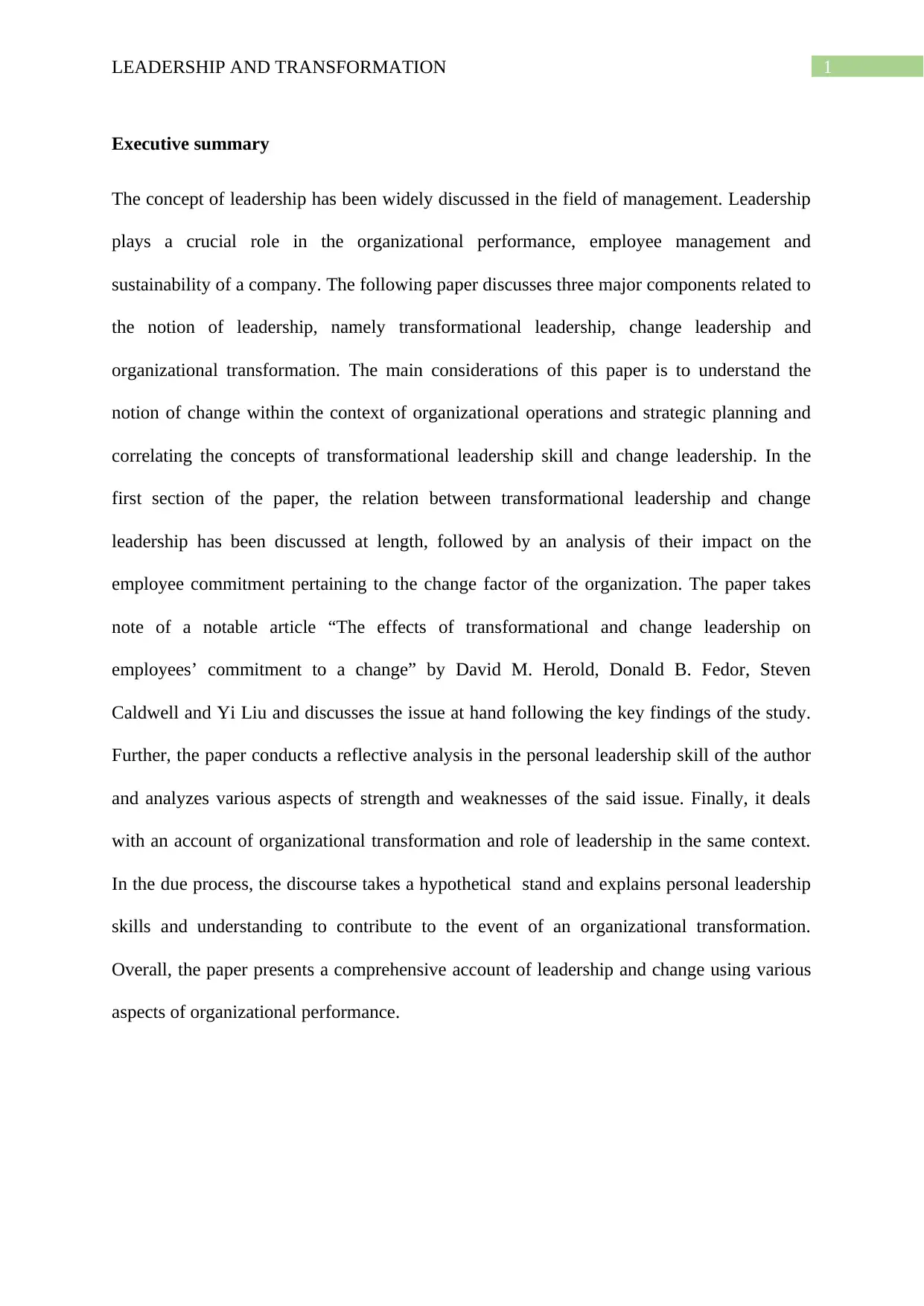
1LEADERSHIP AND TRANSFORMATION
Executive summary
The concept of leadership has been widely discussed in the field of management. Leadership
plays a crucial role in the organizational performance, employee management and
sustainability of a company. The following paper discusses three major components related to
the notion of leadership, namely transformational leadership, change leadership and
organizational transformation. The main considerations of this paper is to understand the
notion of change within the context of organizational operations and strategic planning and
correlating the concepts of transformational leadership skill and change leadership. In the
first section of the paper, the relation between transformational leadership and change
leadership has been discussed at length, followed by an analysis of their impact on the
employee commitment pertaining to the change factor of the organization. The paper takes
note of a notable article “The effects of transformational and change leadership on
employees’ commitment to a change” by David M. Herold, Donald B. Fedor, Steven
Caldwell and Yi Liu and discusses the issue at hand following the key findings of the study.
Further, the paper conducts a reflective analysis in the personal leadership skill of the author
and analyzes various aspects of strength and weaknesses of the said issue. Finally, it deals
with an account of organizational transformation and role of leadership in the same context.
In the due process, the discourse takes a hypothetical stand and explains personal leadership
skills and understanding to contribute to the event of an organizational transformation.
Overall, the paper presents a comprehensive account of leadership and change using various
aspects of organizational performance.
Executive summary
The concept of leadership has been widely discussed in the field of management. Leadership
plays a crucial role in the organizational performance, employee management and
sustainability of a company. The following paper discusses three major components related to
the notion of leadership, namely transformational leadership, change leadership and
organizational transformation. The main considerations of this paper is to understand the
notion of change within the context of organizational operations and strategic planning and
correlating the concepts of transformational leadership skill and change leadership. In the
first section of the paper, the relation between transformational leadership and change
leadership has been discussed at length, followed by an analysis of their impact on the
employee commitment pertaining to the change factor of the organization. The paper takes
note of a notable article “The effects of transformational and change leadership on
employees’ commitment to a change” by David M. Herold, Donald B. Fedor, Steven
Caldwell and Yi Liu and discusses the issue at hand following the key findings of the study.
Further, the paper conducts a reflective analysis in the personal leadership skill of the author
and analyzes various aspects of strength and weaknesses of the said issue. Finally, it deals
with an account of organizational transformation and role of leadership in the same context.
In the due process, the discourse takes a hypothetical stand and explains personal leadership
skills and understanding to contribute to the event of an organizational transformation.
Overall, the paper presents a comprehensive account of leadership and change using various
aspects of organizational performance.
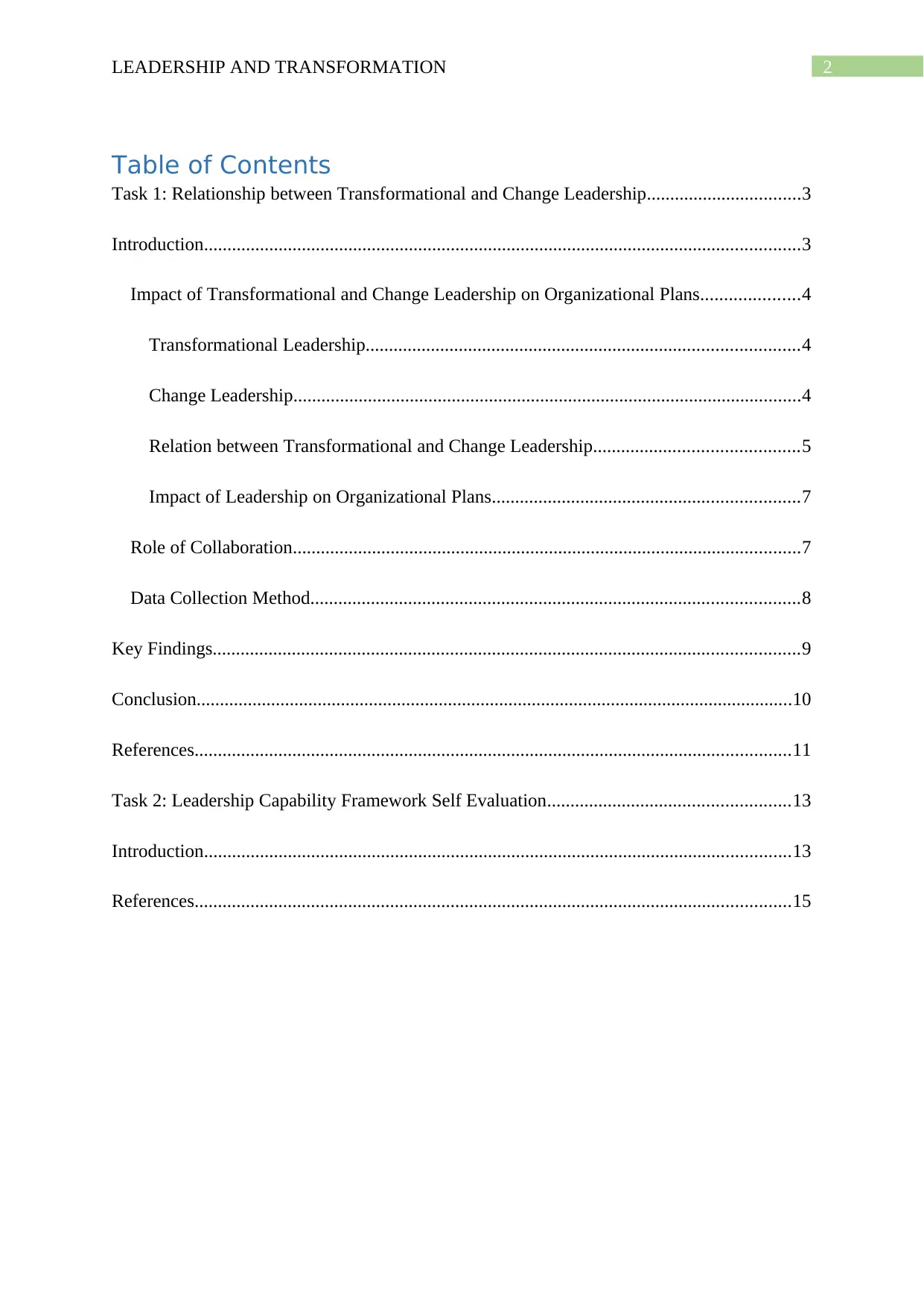
2LEADERSHIP AND TRANSFORMATION
Table of Contents
Task 1: Relationship between Transformational and Change Leadership.................................3
Introduction................................................................................................................................3
Impact of Transformational and Change Leadership on Organizational Plans.....................4
Transformational Leadership.............................................................................................4
Change Leadership.............................................................................................................4
Relation between Transformational and Change Leadership............................................5
Impact of Leadership on Organizational Plans..................................................................7
Role of Collaboration.............................................................................................................7
Data Collection Method.........................................................................................................8
Key Findings..............................................................................................................................9
Conclusion................................................................................................................................10
References................................................................................................................................11
Task 2: Leadership Capability Framework Self Evaluation....................................................13
Introduction..............................................................................................................................13
References................................................................................................................................15
Table of Contents
Task 1: Relationship between Transformational and Change Leadership.................................3
Introduction................................................................................................................................3
Impact of Transformational and Change Leadership on Organizational Plans.....................4
Transformational Leadership.............................................................................................4
Change Leadership.............................................................................................................4
Relation between Transformational and Change Leadership............................................5
Impact of Leadership on Organizational Plans..................................................................7
Role of Collaboration.............................................................................................................7
Data Collection Method.........................................................................................................8
Key Findings..............................................................................................................................9
Conclusion................................................................................................................................10
References................................................................................................................................11
Task 2: Leadership Capability Framework Self Evaluation....................................................13
Introduction..............................................................................................................................13
References................................................................................................................................15
⊘ This is a preview!⊘
Do you want full access?
Subscribe today to unlock all pages.

Trusted by 1+ million students worldwide

3LEADERSHIP AND TRANSFORMATION
Task 1: Relationship between Transformational and Change Leadership
Introduction
Leadership plays an important role in the business activities and processes of an
organization. The management of the leaders thereby ensuring the fulfillment of the
organizational objectives directs the efficiency of the functions and operations. The
performance of the employees is also directly influenced by the ability of the leaders to
induce motivation, encouragement and commitment towards organizational values (Hurduzeu,
2015).
There are various styles of leadership that can be observed in various organizational
structures. In this aspect, transformational leadership is an effective style pertaining to the
implementation and management of changes within the scope of the organization (Ghasabeh,
Soosay & Reaiche, 2015). The process of managing organizational changes also requires the
leaders to not only commit to the process of its implementation but also the intention to
support such changes so that they are well integrated among the various internal and external
stakeholders. The impact of leadership on organizational change pertains to certain
fundamental components such as the leader’s ability to influence the employees and stimulate
their intellect (Hattie, 2015). However, the scope of transformational leadership is not limited
to specific situations pertaining to the implementation of organizational changes, but extends
on a cross-situational plane where the role of the leader is to provide a distinct vision for the
employees to follow (Herold, 2008)
The report will further analyze various aspects of transformational and change
leadership as presented in the article “The effects of transformational and change leadership
Task 1: Relationship between Transformational and Change Leadership
Introduction
Leadership plays an important role in the business activities and processes of an
organization. The management of the leaders thereby ensuring the fulfillment of the
organizational objectives directs the efficiency of the functions and operations. The
performance of the employees is also directly influenced by the ability of the leaders to
induce motivation, encouragement and commitment towards organizational values (Hurduzeu,
2015).
There are various styles of leadership that can be observed in various organizational
structures. In this aspect, transformational leadership is an effective style pertaining to the
implementation and management of changes within the scope of the organization (Ghasabeh,
Soosay & Reaiche, 2015). The process of managing organizational changes also requires the
leaders to not only commit to the process of its implementation but also the intention to
support such changes so that they are well integrated among the various internal and external
stakeholders. The impact of leadership on organizational change pertains to certain
fundamental components such as the leader’s ability to influence the employees and stimulate
their intellect (Hattie, 2015). However, the scope of transformational leadership is not limited
to specific situations pertaining to the implementation of organizational changes, but extends
on a cross-situational plane where the role of the leader is to provide a distinct vision for the
employees to follow (Herold, 2008)
The report will further analyze various aspects of transformational and change
leadership as presented in the article “The effects of transformational and change leadership
Paraphrase This Document
Need a fresh take? Get an instant paraphrase of this document with our AI Paraphraser

4LEADERSHIP AND TRANSFORMATION
on employees’ commitment to a change” by David M. Herold, Donald B. Fedor, Steven
Caldwell and Yi Liu. The impact of various styles of leadership on the attitude and
performance of the employees will also be discussed pertaining to the organizational
objectives and how they are met through a process of change implementation.
Impact of Transformational and Change Leadership on Organizational Plans
Transformational Leadership
Transformational leadership can be described as the ability observed among leaders to
develop and integrate values and a vision that can encourage the followers to adapt and
accommodate changes (Bass & Riggio, 2006). The development of an organizational vision
also encompasses the need for its communication along with the creation of empowering
opportunities. Among other factors observed in transformational style of leadership,
admiration, trust and credibility are of primary importance. Transformational leadership is
conceptualized on a dual level, namely individual and work unit. Individual level comprises
of discretionary stimuli that involves the leader’s attention on the individual employees
differentially. Group or work unit level involves ambient stimuli that is experienced and
shared by groups of employees. (Herold et al., 2008)
Change Leadership
Change leadership involves the process by which organizational changes are
strategized and implemented by the leaders (Hughes & Ford, 2016). This style of leadership can
be described as the leader’s ability to enthuse and motivate the followers or employees
through drive, vision and personal advocacy and provide an adequate access of resources so
as to build a solid foundation for the implementation of changes within the scope of the
organization (Holten & Brenner, 2015). Change leadership follows a participative style
involving the opinions and ideation of the employees in order to strategies the policies of
on employees’ commitment to a change” by David M. Herold, Donald B. Fedor, Steven
Caldwell and Yi Liu. The impact of various styles of leadership on the attitude and
performance of the employees will also be discussed pertaining to the organizational
objectives and how they are met through a process of change implementation.
Impact of Transformational and Change Leadership on Organizational Plans
Transformational Leadership
Transformational leadership can be described as the ability observed among leaders to
develop and integrate values and a vision that can encourage the followers to adapt and
accommodate changes (Bass & Riggio, 2006). The development of an organizational vision
also encompasses the need for its communication along with the creation of empowering
opportunities. Among other factors observed in transformational style of leadership,
admiration, trust and credibility are of primary importance. Transformational leadership is
conceptualized on a dual level, namely individual and work unit. Individual level comprises
of discretionary stimuli that involves the leader’s attention on the individual employees
differentially. Group or work unit level involves ambient stimuli that is experienced and
shared by groups of employees. (Herold et al., 2008)
Change Leadership
Change leadership involves the process by which organizational changes are
strategized and implemented by the leaders (Hughes & Ford, 2016). This style of leadership can
be described as the leader’s ability to enthuse and motivate the followers or employees
through drive, vision and personal advocacy and provide an adequate access of resources so
as to build a solid foundation for the implementation of changes within the scope of the
organization (Holten & Brenner, 2015). Change leadership follows a participative style
involving the opinions and ideation of the employees in order to strategies the policies of
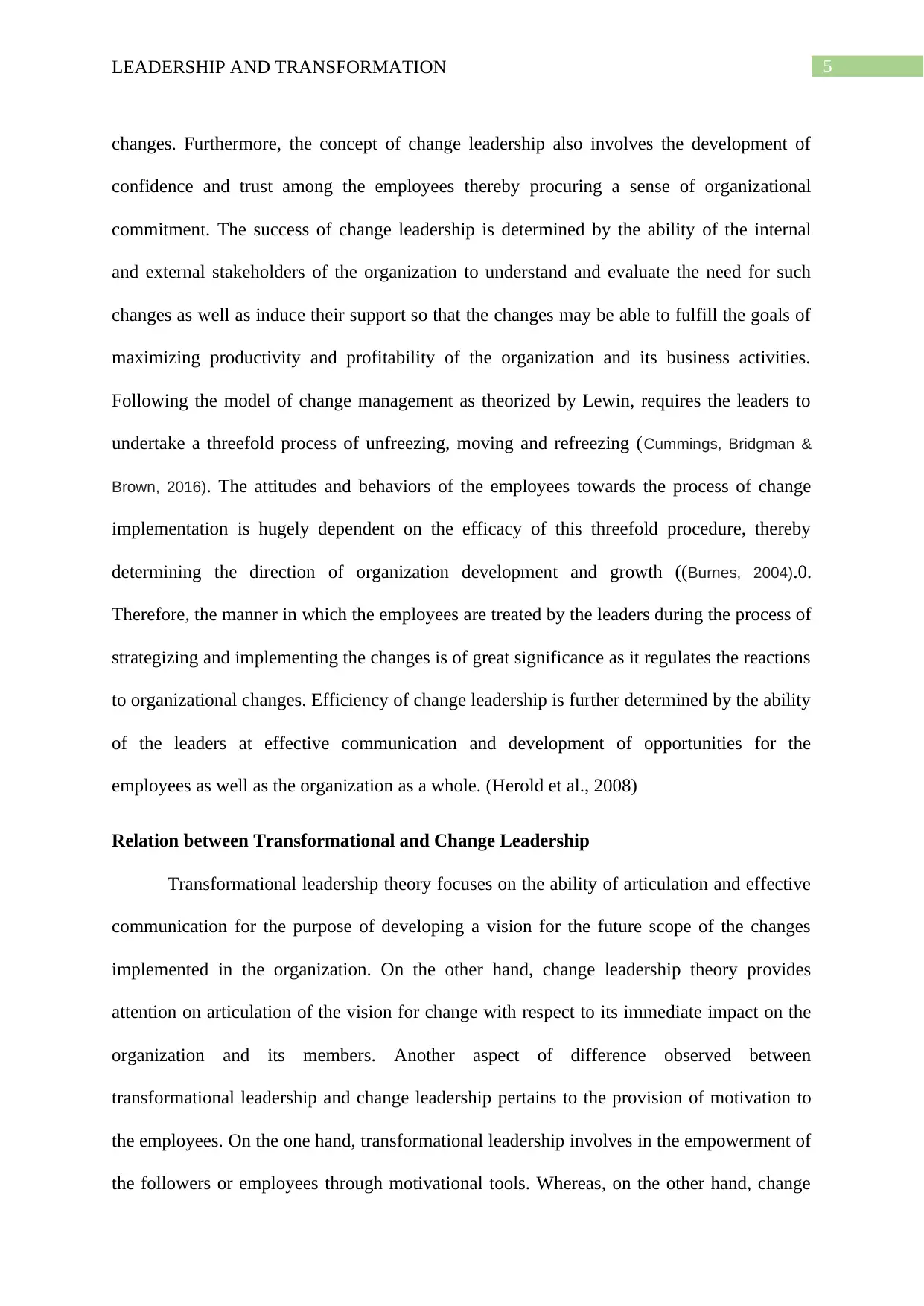
5LEADERSHIP AND TRANSFORMATION
changes. Furthermore, the concept of change leadership also involves the development of
confidence and trust among the employees thereby procuring a sense of organizational
commitment. The success of change leadership is determined by the ability of the internal
and external stakeholders of the organization to understand and evaluate the need for such
changes as well as induce their support so that the changes may be able to fulfill the goals of
maximizing productivity and profitability of the organization and its business activities.
Following the model of change management as theorized by Lewin, requires the leaders to
undertake a threefold process of unfreezing, moving and refreezing (Cummings, Bridgman &
Brown, 2016). The attitudes and behaviors of the employees towards the process of change
implementation is hugely dependent on the efficacy of this threefold procedure, thereby
determining the direction of organization development and growth ((Burnes, 2004).0.
Therefore, the manner in which the employees are treated by the leaders during the process of
strategizing and implementing the changes is of great significance as it regulates the reactions
to organizational changes. Efficiency of change leadership is further determined by the ability
of the leaders at effective communication and development of opportunities for the
employees as well as the organization as a whole. (Herold et al., 2008)
Relation between Transformational and Change Leadership
Transformational leadership theory focuses on the ability of articulation and effective
communication for the purpose of developing a vision for the future scope of the changes
implemented in the organization. On the other hand, change leadership theory provides
attention on articulation of the vision for change with respect to its immediate impact on the
organization and its members. Another aspect of difference observed between
transformational leadership and change leadership pertains to the provision of motivation to
the employees. On the one hand, transformational leadership involves in the empowerment of
the followers or employees through motivational tools. Whereas, on the other hand, change
changes. Furthermore, the concept of change leadership also involves the development of
confidence and trust among the employees thereby procuring a sense of organizational
commitment. The success of change leadership is determined by the ability of the internal
and external stakeholders of the organization to understand and evaluate the need for such
changes as well as induce their support so that the changes may be able to fulfill the goals of
maximizing productivity and profitability of the organization and its business activities.
Following the model of change management as theorized by Lewin, requires the leaders to
undertake a threefold process of unfreezing, moving and refreezing (Cummings, Bridgman &
Brown, 2016). The attitudes and behaviors of the employees towards the process of change
implementation is hugely dependent on the efficacy of this threefold procedure, thereby
determining the direction of organization development and growth ((Burnes, 2004).0.
Therefore, the manner in which the employees are treated by the leaders during the process of
strategizing and implementing the changes is of great significance as it regulates the reactions
to organizational changes. Efficiency of change leadership is further determined by the ability
of the leaders at effective communication and development of opportunities for the
employees as well as the organization as a whole. (Herold et al., 2008)
Relation between Transformational and Change Leadership
Transformational leadership theory focuses on the ability of articulation and effective
communication for the purpose of developing a vision for the future scope of the changes
implemented in the organization. On the other hand, change leadership theory provides
attention on articulation of the vision for change with respect to its immediate impact on the
organization and its members. Another aspect of difference observed between
transformational leadership and change leadership pertains to the provision of motivation to
the employees. On the one hand, transformational leadership involves in the empowerment of
the followers or employees through motivational tools. Whereas, on the other hand, change
⊘ This is a preview!⊘
Do you want full access?
Subscribe today to unlock all pages.

Trusted by 1+ million students worldwide
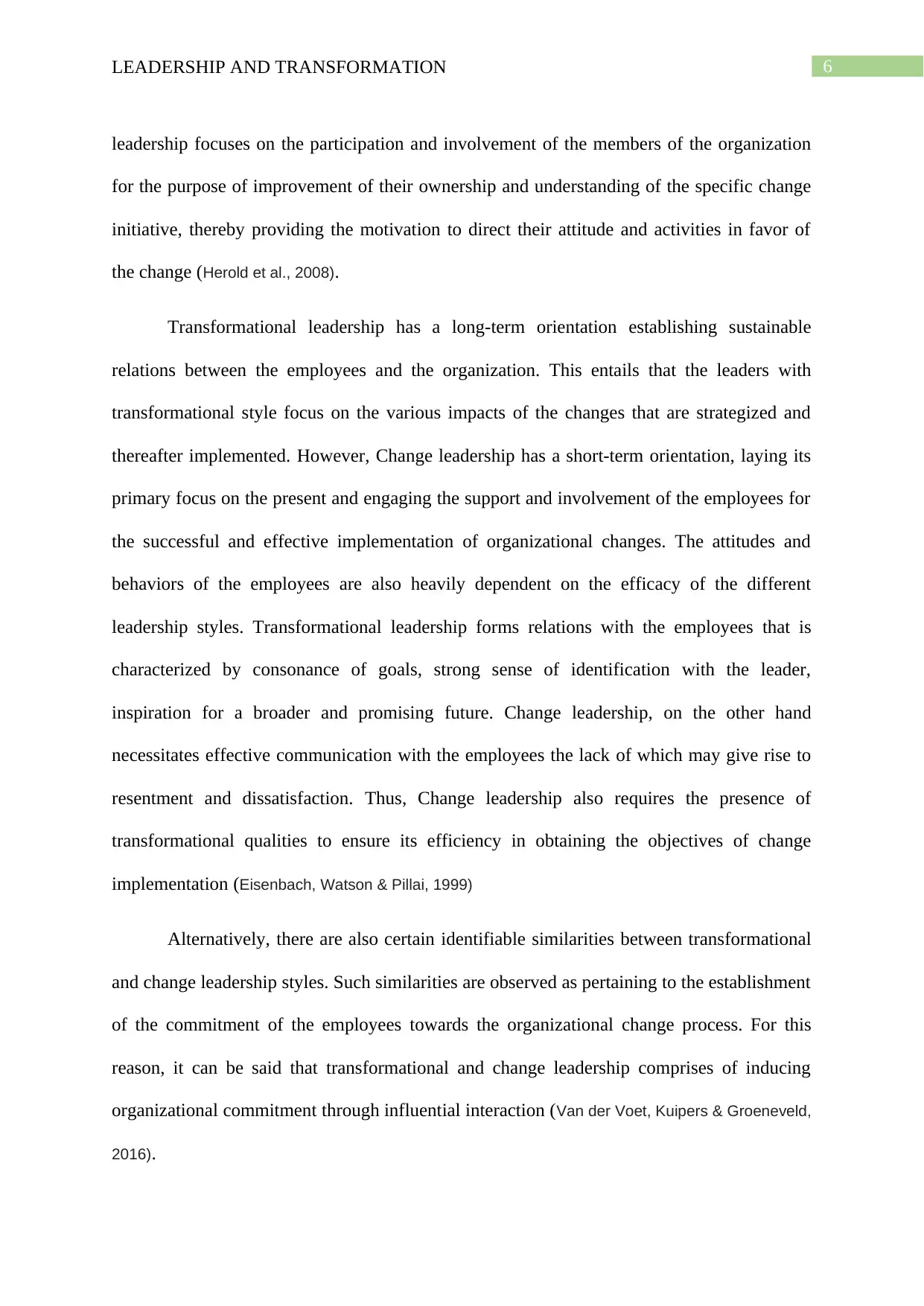
6LEADERSHIP AND TRANSFORMATION
leadership focuses on the participation and involvement of the members of the organization
for the purpose of improvement of their ownership and understanding of the specific change
initiative, thereby providing the motivation to direct their attitude and activities in favor of
the change (Herold et al., 2008).
Transformational leadership has a long-term orientation establishing sustainable
relations between the employees and the organization. This entails that the leaders with
transformational style focus on the various impacts of the changes that are strategized and
thereafter implemented. However, Change leadership has a short-term orientation, laying its
primary focus on the present and engaging the support and involvement of the employees for
the successful and effective implementation of organizational changes. The attitudes and
behaviors of the employees are also heavily dependent on the efficacy of the different
leadership styles. Transformational leadership forms relations with the employees that is
characterized by consonance of goals, strong sense of identification with the leader,
inspiration for a broader and promising future. Change leadership, on the other hand
necessitates effective communication with the employees the lack of which may give rise to
resentment and dissatisfaction. Thus, Change leadership also requires the presence of
transformational qualities to ensure its efficiency in obtaining the objectives of change
implementation (Eisenbach, Watson & Pillai, 1999)
Alternatively, there are also certain identifiable similarities between transformational
and change leadership styles. Such similarities are observed as pertaining to the establishment
of the commitment of the employees towards the organizational change process. For this
reason, it can be said that transformational and change leadership comprises of inducing
organizational commitment through influential interaction (Van der Voet, Kuipers & Groeneveld,
2016).
leadership focuses on the participation and involvement of the members of the organization
for the purpose of improvement of their ownership and understanding of the specific change
initiative, thereby providing the motivation to direct their attitude and activities in favor of
the change (Herold et al., 2008).
Transformational leadership has a long-term orientation establishing sustainable
relations between the employees and the organization. This entails that the leaders with
transformational style focus on the various impacts of the changes that are strategized and
thereafter implemented. However, Change leadership has a short-term orientation, laying its
primary focus on the present and engaging the support and involvement of the employees for
the successful and effective implementation of organizational changes. The attitudes and
behaviors of the employees are also heavily dependent on the efficacy of the different
leadership styles. Transformational leadership forms relations with the employees that is
characterized by consonance of goals, strong sense of identification with the leader,
inspiration for a broader and promising future. Change leadership, on the other hand
necessitates effective communication with the employees the lack of which may give rise to
resentment and dissatisfaction. Thus, Change leadership also requires the presence of
transformational qualities to ensure its efficiency in obtaining the objectives of change
implementation (Eisenbach, Watson & Pillai, 1999)
Alternatively, there are also certain identifiable similarities between transformational
and change leadership styles. Such similarities are observed as pertaining to the establishment
of the commitment of the employees towards the organizational change process. For this
reason, it can be said that transformational and change leadership comprises of inducing
organizational commitment through influential interaction (Van der Voet, Kuipers & Groeneveld,
2016).
Paraphrase This Document
Need a fresh take? Get an instant paraphrase of this document with our AI Paraphraser
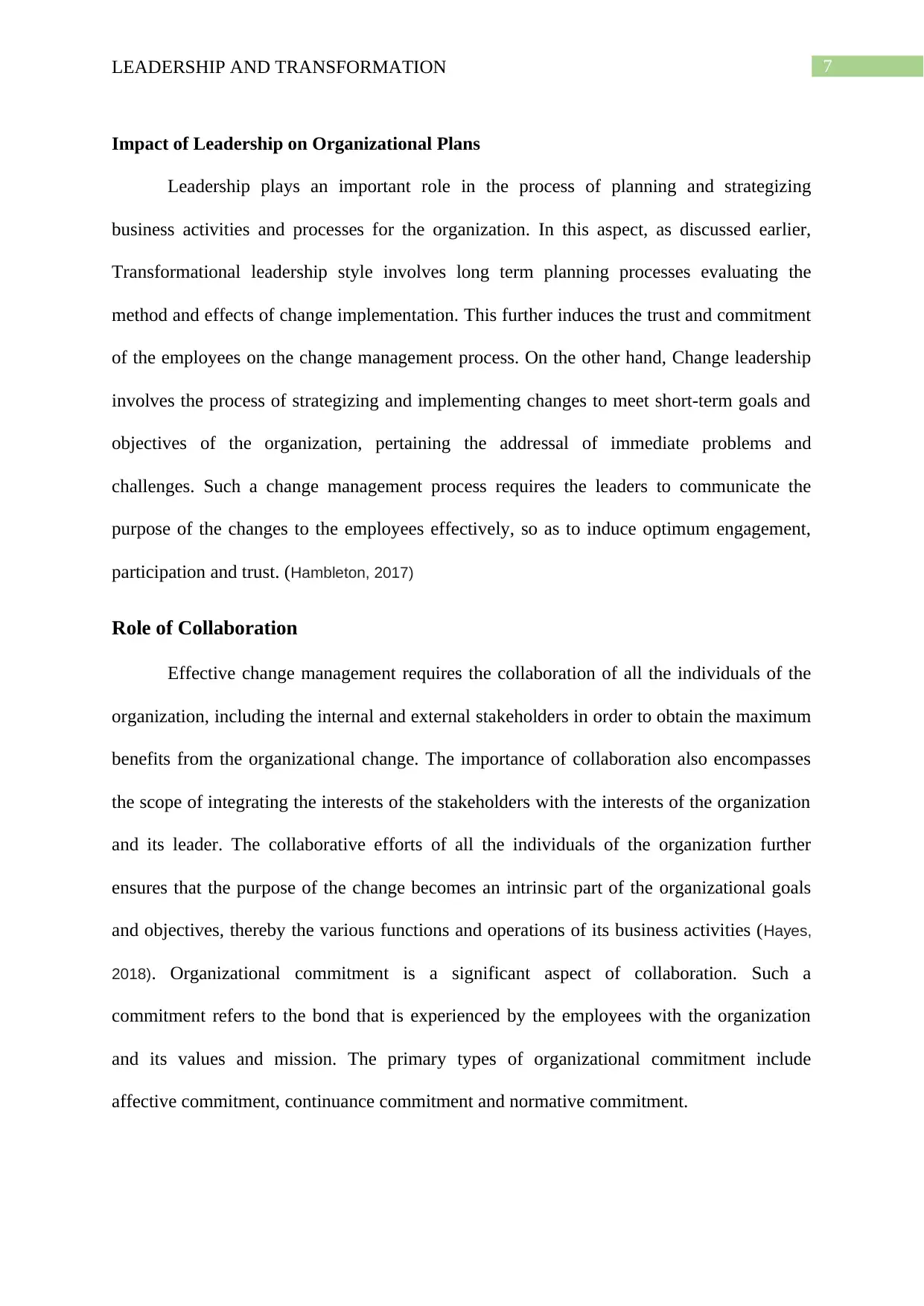
7LEADERSHIP AND TRANSFORMATION
Impact of Leadership on Organizational Plans
Leadership plays an important role in the process of planning and strategizing
business activities and processes for the organization. In this aspect, as discussed earlier,
Transformational leadership style involves long term planning processes evaluating the
method and effects of change implementation. This further induces the trust and commitment
of the employees on the change management process. On the other hand, Change leadership
involves the process of strategizing and implementing changes to meet short-term goals and
objectives of the organization, pertaining the addressal of immediate problems and
challenges. Such a change management process requires the leaders to communicate the
purpose of the changes to the employees effectively, so as to induce optimum engagement,
participation and trust. (Hambleton, 2017)
Role of Collaboration
Effective change management requires the collaboration of all the individuals of the
organization, including the internal and external stakeholders in order to obtain the maximum
benefits from the organizational change. The importance of collaboration also encompasses
the scope of integrating the interests of the stakeholders with the interests of the organization
and its leader. The collaborative efforts of all the individuals of the organization further
ensures that the purpose of the change becomes an intrinsic part of the organizational goals
and objectives, thereby the various functions and operations of its business activities (Hayes,
2018). Organizational commitment is a significant aspect of collaboration. Such a
commitment refers to the bond that is experienced by the employees with the organization
and its values and mission. The primary types of organizational commitment include
affective commitment, continuance commitment and normative commitment.
Impact of Leadership on Organizational Plans
Leadership plays an important role in the process of planning and strategizing
business activities and processes for the organization. In this aspect, as discussed earlier,
Transformational leadership style involves long term planning processes evaluating the
method and effects of change implementation. This further induces the trust and commitment
of the employees on the change management process. On the other hand, Change leadership
involves the process of strategizing and implementing changes to meet short-term goals and
objectives of the organization, pertaining the addressal of immediate problems and
challenges. Such a change management process requires the leaders to communicate the
purpose of the changes to the employees effectively, so as to induce optimum engagement,
participation and trust. (Hambleton, 2017)
Role of Collaboration
Effective change management requires the collaboration of all the individuals of the
organization, including the internal and external stakeholders in order to obtain the maximum
benefits from the organizational change. The importance of collaboration also encompasses
the scope of integrating the interests of the stakeholders with the interests of the organization
and its leader. The collaborative efforts of all the individuals of the organization further
ensures that the purpose of the change becomes an intrinsic part of the organizational goals
and objectives, thereby the various functions and operations of its business activities (Hayes,
2018). Organizational commitment is a significant aspect of collaboration. Such a
commitment refers to the bond that is experienced by the employees with the organization
and its values and mission. The primary types of organizational commitment include
affective commitment, continuance commitment and normative commitment.
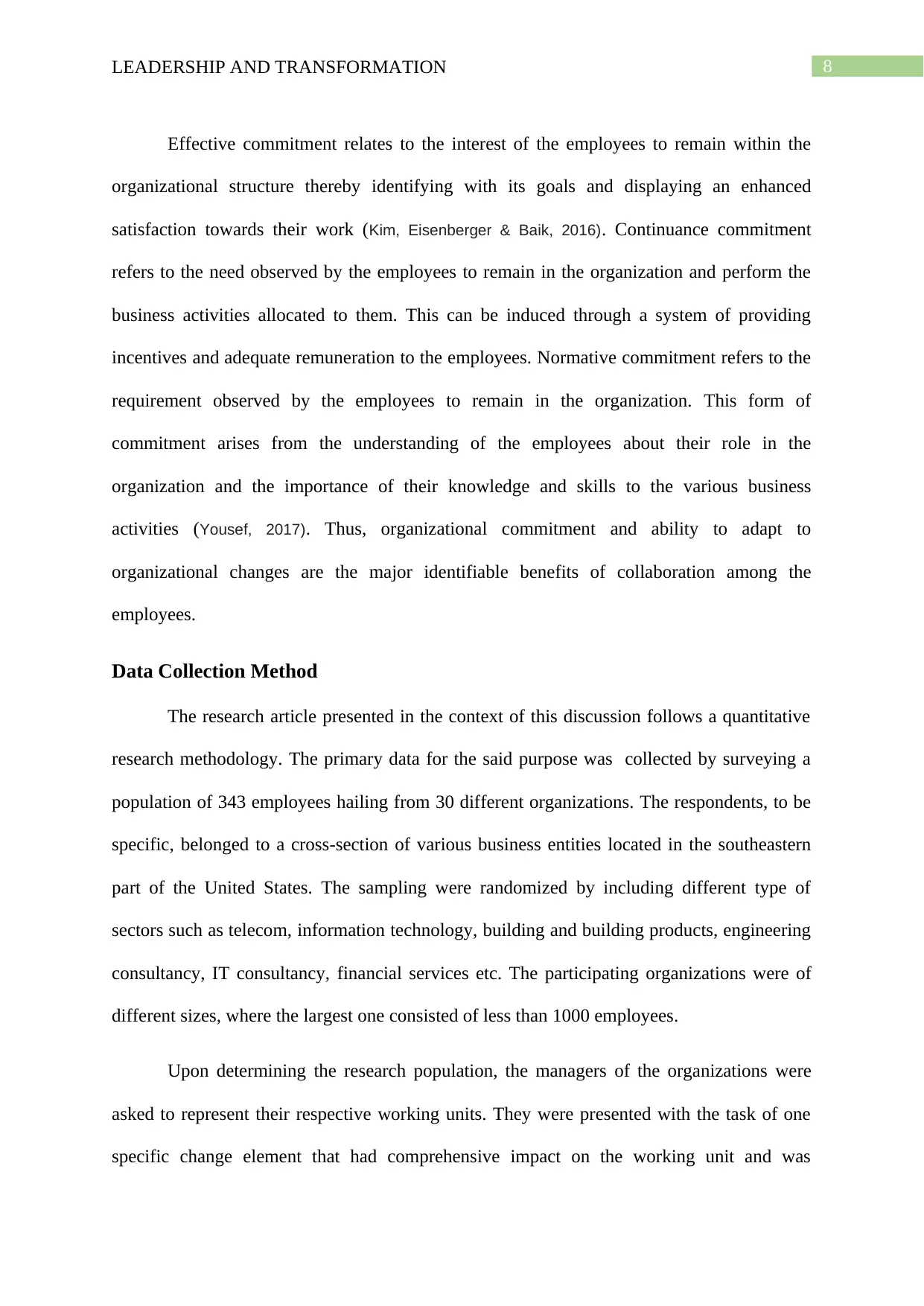
8LEADERSHIP AND TRANSFORMATION
Effective commitment relates to the interest of the employees to remain within the
organizational structure thereby identifying with its goals and displaying an enhanced
satisfaction towards their work (Kim, Eisenberger & Baik, 2016). Continuance commitment
refers to the need observed by the employees to remain in the organization and perform the
business activities allocated to them. This can be induced through a system of providing
incentives and adequate remuneration to the employees. Normative commitment refers to the
requirement observed by the employees to remain in the organization. This form of
commitment arises from the understanding of the employees about their role in the
organization and the importance of their knowledge and skills to the various business
activities (Yousef, 2017). Thus, organizational commitment and ability to adapt to
organizational changes are the major identifiable benefits of collaboration among the
employees.
Data Collection Method
The research article presented in the context of this discussion follows a quantitative
research methodology. The primary data for the said purpose was collected by surveying a
population of 343 employees hailing from 30 different organizations. The respondents, to be
specific, belonged to a cross-section of various business entities located in the southeastern
part of the United States. The sampling were randomized by including different type of
sectors such as telecom, information technology, building and building products, engineering
consultancy, IT consultancy, financial services etc. The participating organizations were of
different sizes, where the largest one consisted of less than 1000 employees.
Upon determining the research population, the managers of the organizations were
asked to represent their respective working units. They were presented with the task of one
specific change element that had comprehensive impact on the working unit and was
Effective commitment relates to the interest of the employees to remain within the
organizational structure thereby identifying with its goals and displaying an enhanced
satisfaction towards their work (Kim, Eisenberger & Baik, 2016). Continuance commitment
refers to the need observed by the employees to remain in the organization and perform the
business activities allocated to them. This can be induced through a system of providing
incentives and adequate remuneration to the employees. Normative commitment refers to the
requirement observed by the employees to remain in the organization. This form of
commitment arises from the understanding of the employees about their role in the
organization and the importance of their knowledge and skills to the various business
activities (Yousef, 2017). Thus, organizational commitment and ability to adapt to
organizational changes are the major identifiable benefits of collaboration among the
employees.
Data Collection Method
The research article presented in the context of this discussion follows a quantitative
research methodology. The primary data for the said purpose was collected by surveying a
population of 343 employees hailing from 30 different organizations. The respondents, to be
specific, belonged to a cross-section of various business entities located in the southeastern
part of the United States. The sampling were randomized by including different type of
sectors such as telecom, information technology, building and building products, engineering
consultancy, IT consultancy, financial services etc. The participating organizations were of
different sizes, where the largest one consisted of less than 1000 employees.
Upon determining the research population, the managers of the organizations were
asked to represent their respective working units. They were presented with the task of one
specific change element that had comprehensive impact on the working unit and was
⊘ This is a preview!⊘
Do you want full access?
Subscribe today to unlock all pages.

Trusted by 1+ million students worldwide
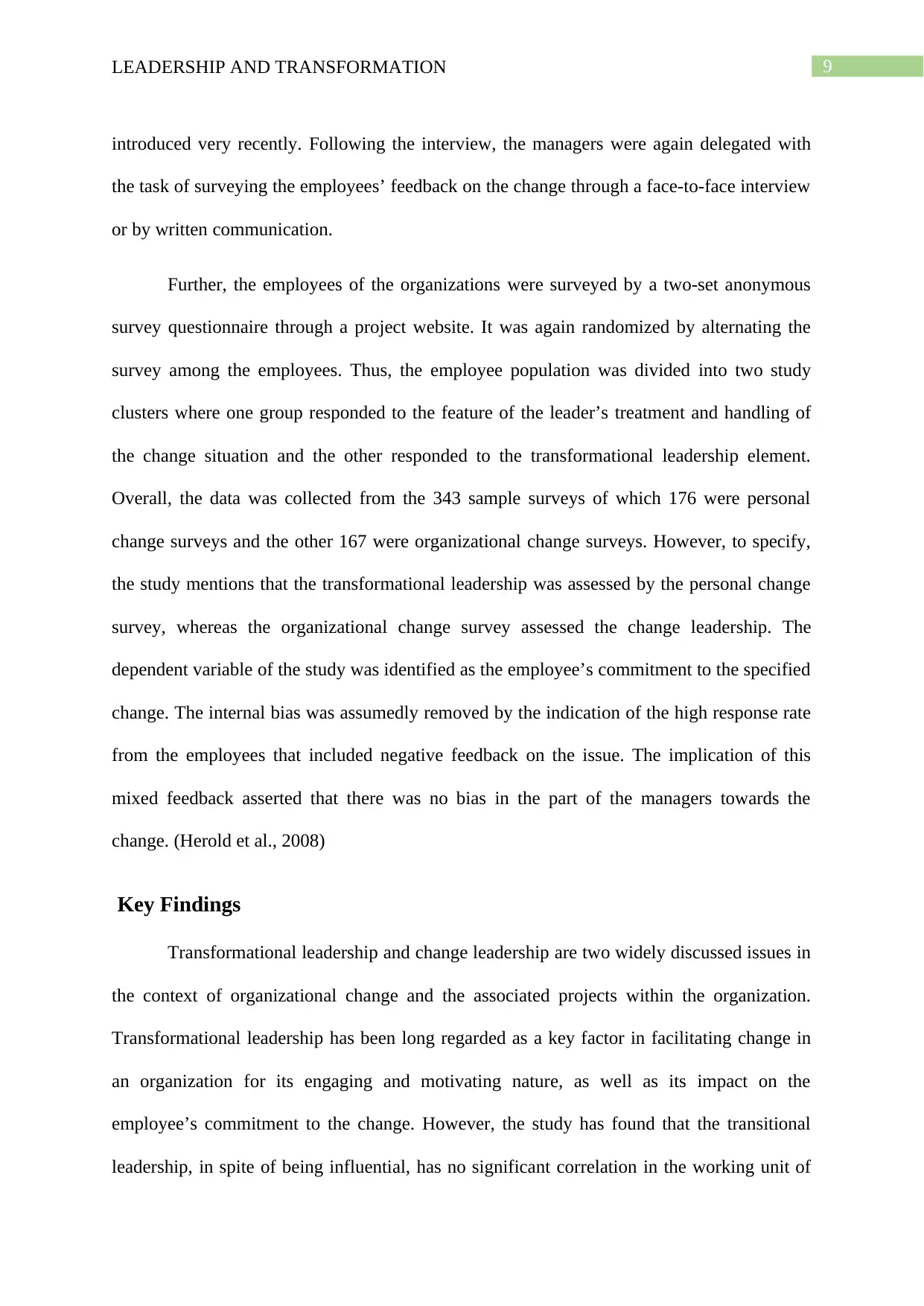
9LEADERSHIP AND TRANSFORMATION
introduced very recently. Following the interview, the managers were again delegated with
the task of surveying the employees’ feedback on the change through a face-to-face interview
or by written communication.
Further, the employees of the organizations were surveyed by a two-set anonymous
survey questionnaire through a project website. It was again randomized by alternating the
survey among the employees. Thus, the employee population was divided into two study
clusters where one group responded to the feature of the leader’s treatment and handling of
the change situation and the other responded to the transformational leadership element.
Overall, the data was collected from the 343 sample surveys of which 176 were personal
change surveys and the other 167 were organizational change surveys. However, to specify,
the study mentions that the transformational leadership was assessed by the personal change
survey, whereas the organizational change survey assessed the change leadership. The
dependent variable of the study was identified as the employee’s commitment to the specified
change. The internal bias was assumedly removed by the indication of the high response rate
from the employees that included negative feedback on the issue. The implication of this
mixed feedback asserted that there was no bias in the part of the managers towards the
change. (Herold et al., 2008)
Key Findings
Transformational leadership and change leadership are two widely discussed issues in
the context of organizational change and the associated projects within the organization.
Transformational leadership has been long regarded as a key factor in facilitating change in
an organization for its engaging and motivating nature, as well as its impact on the
employee’s commitment to the change. However, the study has found that the transitional
leadership, in spite of being influential, has no significant correlation in the working unit of
introduced very recently. Following the interview, the managers were again delegated with
the task of surveying the employees’ feedback on the change through a face-to-face interview
or by written communication.
Further, the employees of the organizations were surveyed by a two-set anonymous
survey questionnaire through a project website. It was again randomized by alternating the
survey among the employees. Thus, the employee population was divided into two study
clusters where one group responded to the feature of the leader’s treatment and handling of
the change situation and the other responded to the transformational leadership element.
Overall, the data was collected from the 343 sample surveys of which 176 were personal
change surveys and the other 167 were organizational change surveys. However, to specify,
the study mentions that the transformational leadership was assessed by the personal change
survey, whereas the organizational change survey assessed the change leadership. The
dependent variable of the study was identified as the employee’s commitment to the specified
change. The internal bias was assumedly removed by the indication of the high response rate
from the employees that included negative feedback on the issue. The implication of this
mixed feedback asserted that there was no bias in the part of the managers towards the
change. (Herold et al., 2008)
Key Findings
Transformational leadership and change leadership are two widely discussed issues in
the context of organizational change and the associated projects within the organization.
Transformational leadership has been long regarded as a key factor in facilitating change in
an organization for its engaging and motivating nature, as well as its impact on the
employee’s commitment to the change. However, the study has found that the transitional
leadership, in spite of being influential, has no significant correlation in the working unit of
Paraphrase This Document
Need a fresh take? Get an instant paraphrase of this document with our AI Paraphraser
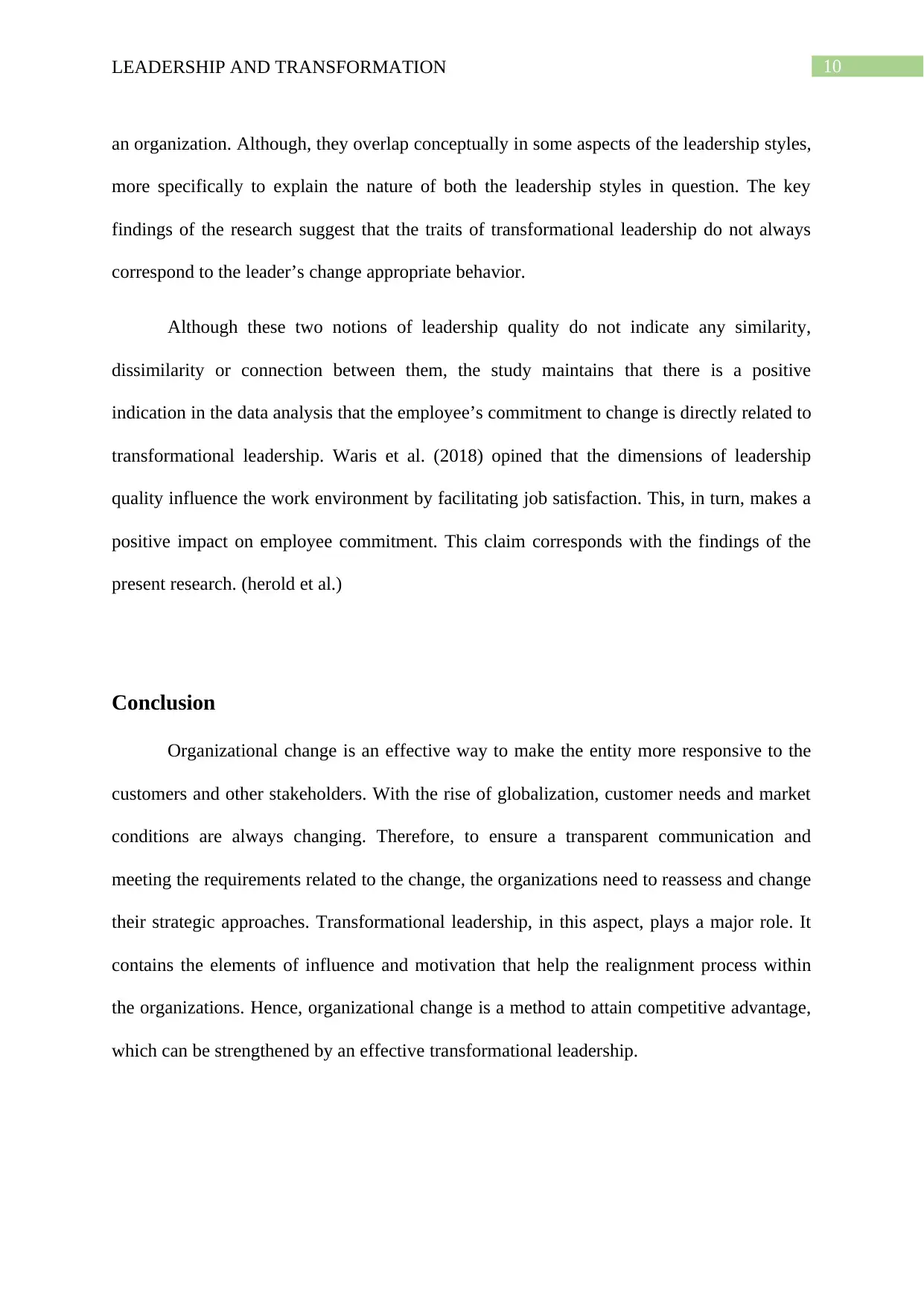
10LEADERSHIP AND TRANSFORMATION
an organization. Although, they overlap conceptually in some aspects of the leadership styles,
more specifically to explain the nature of both the leadership styles in question. The key
findings of the research suggest that the traits of transformational leadership do not always
correspond to the leader’s change appropriate behavior.
Although these two notions of leadership quality do not indicate any similarity,
dissimilarity or connection between them, the study maintains that there is a positive
indication in the data analysis that the employee’s commitment to change is directly related to
transformational leadership. Waris et al. (2018) opined that the dimensions of leadership
quality influence the work environment by facilitating job satisfaction. This, in turn, makes a
positive impact on employee commitment. This claim corresponds with the findings of the
present research. (herold et al.)
Conclusion
Organizational change is an effective way to make the entity more responsive to the
customers and other stakeholders. With the rise of globalization, customer needs and market
conditions are always changing. Therefore, to ensure a transparent communication and
meeting the requirements related to the change, the organizations need to reassess and change
their strategic approaches. Transformational leadership, in this aspect, plays a major role. It
contains the elements of influence and motivation that help the realignment process within
the organizations. Hence, organizational change is a method to attain competitive advantage,
which can be strengthened by an effective transformational leadership.
an organization. Although, they overlap conceptually in some aspects of the leadership styles,
more specifically to explain the nature of both the leadership styles in question. The key
findings of the research suggest that the traits of transformational leadership do not always
correspond to the leader’s change appropriate behavior.
Although these two notions of leadership quality do not indicate any similarity,
dissimilarity or connection between them, the study maintains that there is a positive
indication in the data analysis that the employee’s commitment to change is directly related to
transformational leadership. Waris et al. (2018) opined that the dimensions of leadership
quality influence the work environment by facilitating job satisfaction. This, in turn, makes a
positive impact on employee commitment. This claim corresponds with the findings of the
present research. (herold et al.)
Conclusion
Organizational change is an effective way to make the entity more responsive to the
customers and other stakeholders. With the rise of globalization, customer needs and market
conditions are always changing. Therefore, to ensure a transparent communication and
meeting the requirements related to the change, the organizations need to reassess and change
their strategic approaches. Transformational leadership, in this aspect, plays a major role. It
contains the elements of influence and motivation that help the realignment process within
the organizations. Hence, organizational change is a method to attain competitive advantage,
which can be strengthened by an effective transformational leadership.
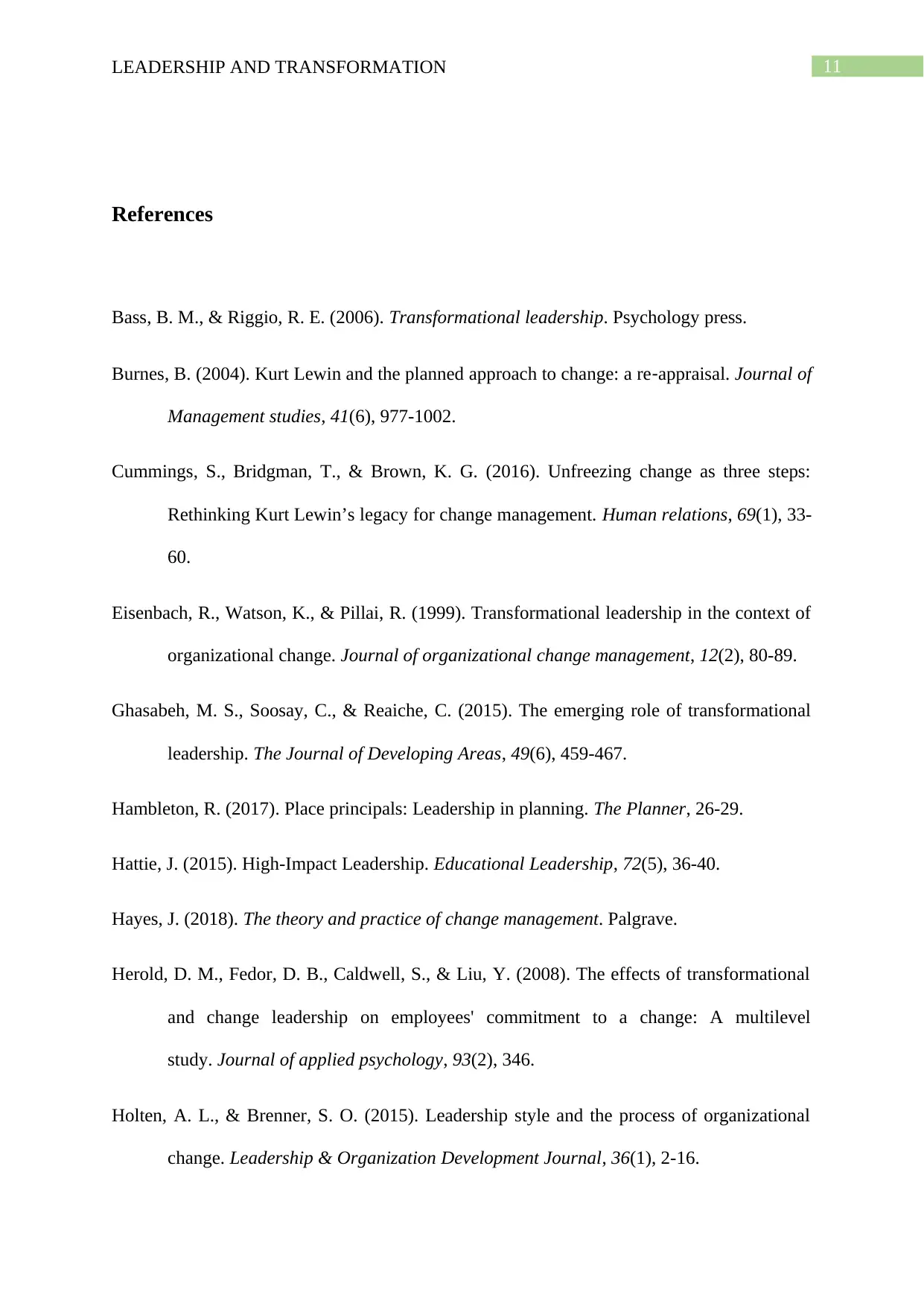
11LEADERSHIP AND TRANSFORMATION
References
Bass, B. M., & Riggio, R. E. (2006). Transformational leadership. Psychology press.
Burnes, B. (2004). Kurt Lewin and the planned approach to change: a re‐appraisal. Journal of
Management studies, 41(6), 977-1002.
Cummings, S., Bridgman, T., & Brown, K. G. (2016). Unfreezing change as three steps:
Rethinking Kurt Lewin’s legacy for change management. Human relations, 69(1), 33-
60.
Eisenbach, R., Watson, K., & Pillai, R. (1999). Transformational leadership in the context of
organizational change. Journal of organizational change management, 12(2), 80-89.
Ghasabeh, M. S., Soosay, C., & Reaiche, C. (2015). The emerging role of transformational
leadership. The Journal of Developing Areas, 49(6), 459-467.
Hambleton, R. (2017). Place principals: Leadership in planning. The Planner, 26-29.
Hattie, J. (2015). High-Impact Leadership. Educational Leadership, 72(5), 36-40.
Hayes, J. (2018). The theory and practice of change management. Palgrave.
Herold, D. M., Fedor, D. B., Caldwell, S., & Liu, Y. (2008). The effects of transformational
and change leadership on employees' commitment to a change: A multilevel
study. Journal of applied psychology, 93(2), 346.
Holten, A. L., & Brenner, S. O. (2015). Leadership style and the process of organizational
change. Leadership & Organization Development Journal, 36(1), 2-16.
References
Bass, B. M., & Riggio, R. E. (2006). Transformational leadership. Psychology press.
Burnes, B. (2004). Kurt Lewin and the planned approach to change: a re‐appraisal. Journal of
Management studies, 41(6), 977-1002.
Cummings, S., Bridgman, T., & Brown, K. G. (2016). Unfreezing change as three steps:
Rethinking Kurt Lewin’s legacy for change management. Human relations, 69(1), 33-
60.
Eisenbach, R., Watson, K., & Pillai, R. (1999). Transformational leadership in the context of
organizational change. Journal of organizational change management, 12(2), 80-89.
Ghasabeh, M. S., Soosay, C., & Reaiche, C. (2015). The emerging role of transformational
leadership. The Journal of Developing Areas, 49(6), 459-467.
Hambleton, R. (2017). Place principals: Leadership in planning. The Planner, 26-29.
Hattie, J. (2015). High-Impact Leadership. Educational Leadership, 72(5), 36-40.
Hayes, J. (2018). The theory and practice of change management. Palgrave.
Herold, D. M., Fedor, D. B., Caldwell, S., & Liu, Y. (2008). The effects of transformational
and change leadership on employees' commitment to a change: A multilevel
study. Journal of applied psychology, 93(2), 346.
Holten, A. L., & Brenner, S. O. (2015). Leadership style and the process of organizational
change. Leadership & Organization Development Journal, 36(1), 2-16.
⊘ This is a preview!⊘
Do you want full access?
Subscribe today to unlock all pages.

Trusted by 1+ million students worldwide
1 out of 29
Related Documents
Your All-in-One AI-Powered Toolkit for Academic Success.
+13062052269
info@desklib.com
Available 24*7 on WhatsApp / Email
![[object Object]](/_next/static/media/star-bottom.7253800d.svg)
Unlock your academic potential
Copyright © 2020–2025 A2Z Services. All Rights Reserved. Developed and managed by ZUCOL.





